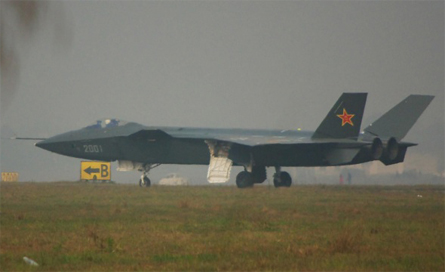Images of a new aircraft purported to be China's fifth-generation fighter have created a stir among aviation enthusiasts, but a true Chinese combat aircraft in this category is probably well over a decade away from readiness.
In late December grainy photographs emerged on Chinese websites of an aircraft described as the fifth-generation Chengdu J-20. Most of the images appeared to show the aircraft during taxi tests, although one especially pixellated image showed what appeared to be the new aircraft close to taking off.
While there is the possibility that the aircraft is a hoax, Chinese air force generals have reportedly hinted about the existence of a fifth-generation fighter programme known as J-XX.
Some similarities to the Lockheed Martin F-22 and Sukhoi's PAK-FA/T-50 demonstrator are apparent. The J-20 features a blended fuselage and large, canted twin tails, while its fuselage has some low-observable characteristics. On the other hand, the aircraft's thrust nozzles are clearly fixed, whereas thrust vectoring has become de rigueur for even some fourth-generation fighters.
 |
|---|
Douglas Barrie, senior fellow for military aerospace at the International Institute for Strategic Studies, warns about concluding much based on available images.
"Drawing even tentative conclusions about anything other than the basic airframe configuration strikes me as speculative," he says. "The canard-delta configuration, coupled with canted vertical fins, is reminiscent of MiG's now cancelled 1.42 programme, and it would be interesting to know why the Chinese designers settled on this approach, rather than that of the Lockheed F-22 or Sukhoi T-50 platform."
Barrie says Sukhoi moved away from the "tri-plane" configuration in its latest revision of the Su-27, the Su-27SM2/Su-35, which disposes of the canard design of the Su-27M.
The J-20 also appears to be very large for a fighter. In one photo it dwarfs a truck, suggesting a size similar to the General Dynamics F-111, or perhaps more appropriately the long-retired Tupolev Tu-128. Size alone could suggest that the aircraft is not a fighter, but a bomber.
Teal Group analyst Richard Aboulafia is also dubious about the new aircraft. "I'm less sure that it's even much of an impressive airframe," he says. "There are two rather large canards. I'm not sure that can be reconciled with a low-observable design. It looks like something that might have been designed in 1985."
Despite China's clear ambitions to be a leader in both civil and military aviation, other programmes suggest that it lacks the building blocks to create a truly fifth-generation combat aircraft.
 |
|---|
This pixellated image suggests that the J-20 has come close to flying |
Chengdu's fourth-generation J-10 first appeared in 2006 after a decade of testing, but many experts feel it is comparable with Western aircraft of the 1980s. More recently, Beijing has struggled to develop the Shenyang J-15 carrier-borne fighter, a reverse-engineered version of the Su-33 that first flew 25 years ago.
One area where China is particularly weak is jet engines, with reports suggesting that its most advanced model, the Shenyang WS-10, requires an overhaul after every 20h of operation. The J-10 uses Russian Saturn AL-31s, as does the J-11B, a locally produced version of the Su-27.
Even the Chengdu JF-17 Thunder - an inexpensive aircraft pitched to developing nations such as Pakistan as a third-generation platform - is powered by the Klimov RD-93.
"People have seen the F-22 and this has given them ideas about how to approach stealth," says Richard Bitzinger, a senior fellow with Singapore's S Rajaratnam School of International Studies' Military Transformations Programme.
He points out that the F-22, the world's only operational stealth fighter, relies not only on a low-observable design, but also on the sophisticated integration of coatings and materials. The US Air Force type is also covered with sensors and avionics, many of which remain classified.
"The J-20 could make its first flight this year, but it is bound to have a long flight-test programme," Bitzinger says. In his view, China's fifth-generation fighter is over a decade away. For the time being the country will focus on cost-effective programmes such as the J-10 and J-11B to replace older types such as its air force's Chengdu J-7s - based on the Mikoyan MiG-21 - and Shenyang J-8s.
Bitzinger says that if China were to field J-10s and J-11Bs in sufficient numbers, it would be able to outclass key regional rivals such as Japan and Taiwan.
Source: Flight International



















